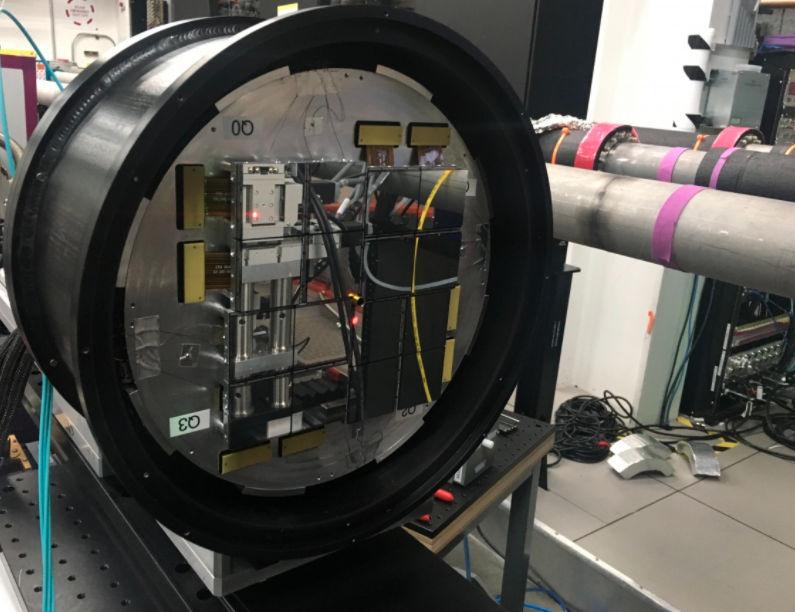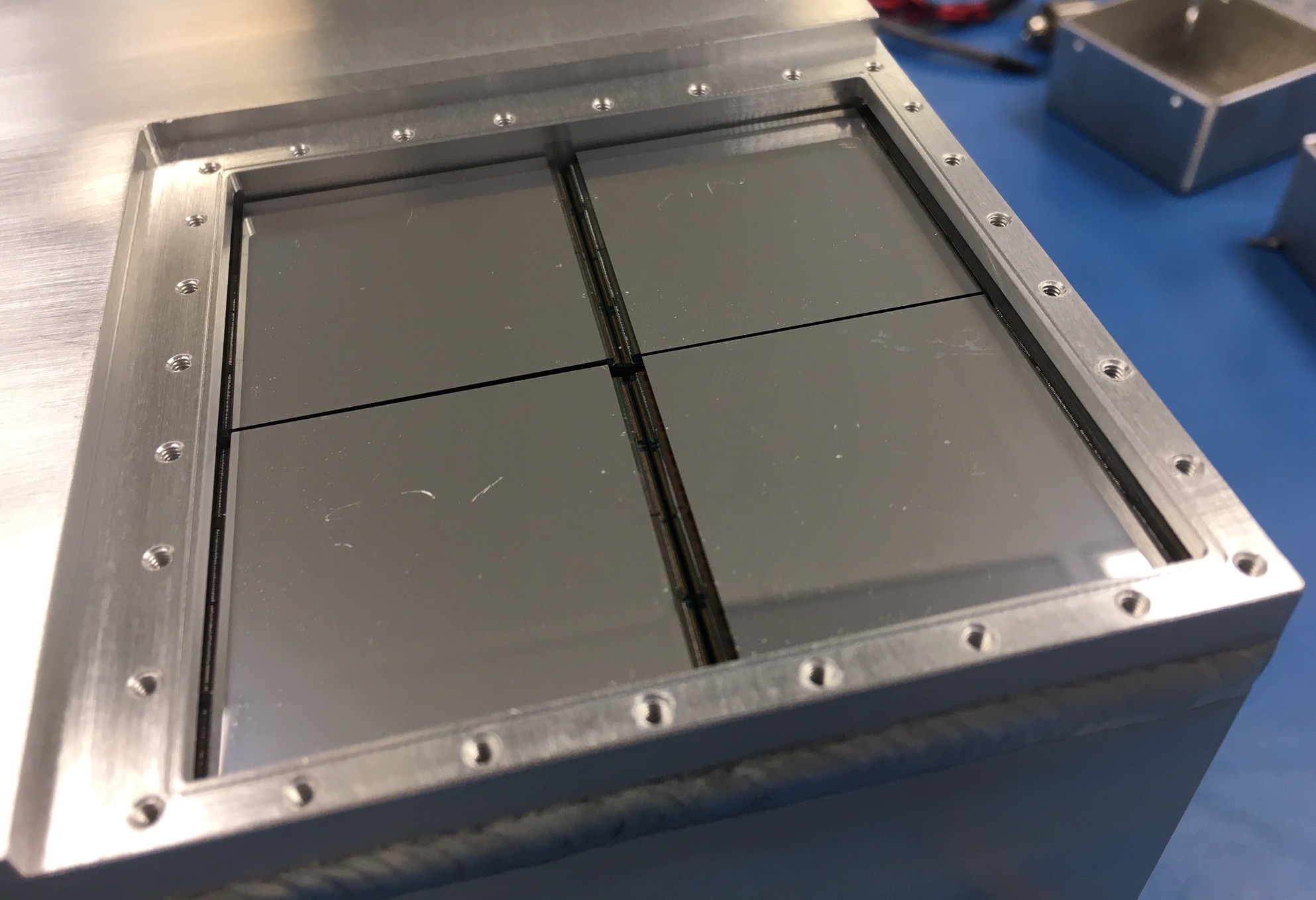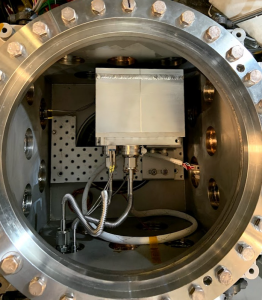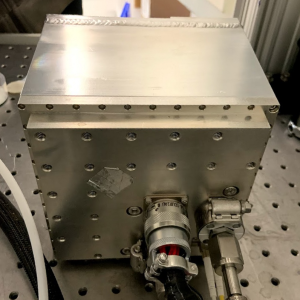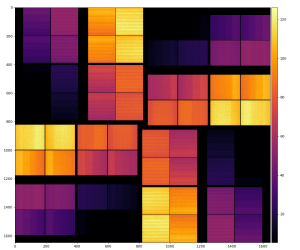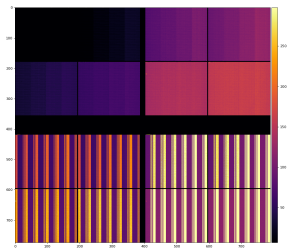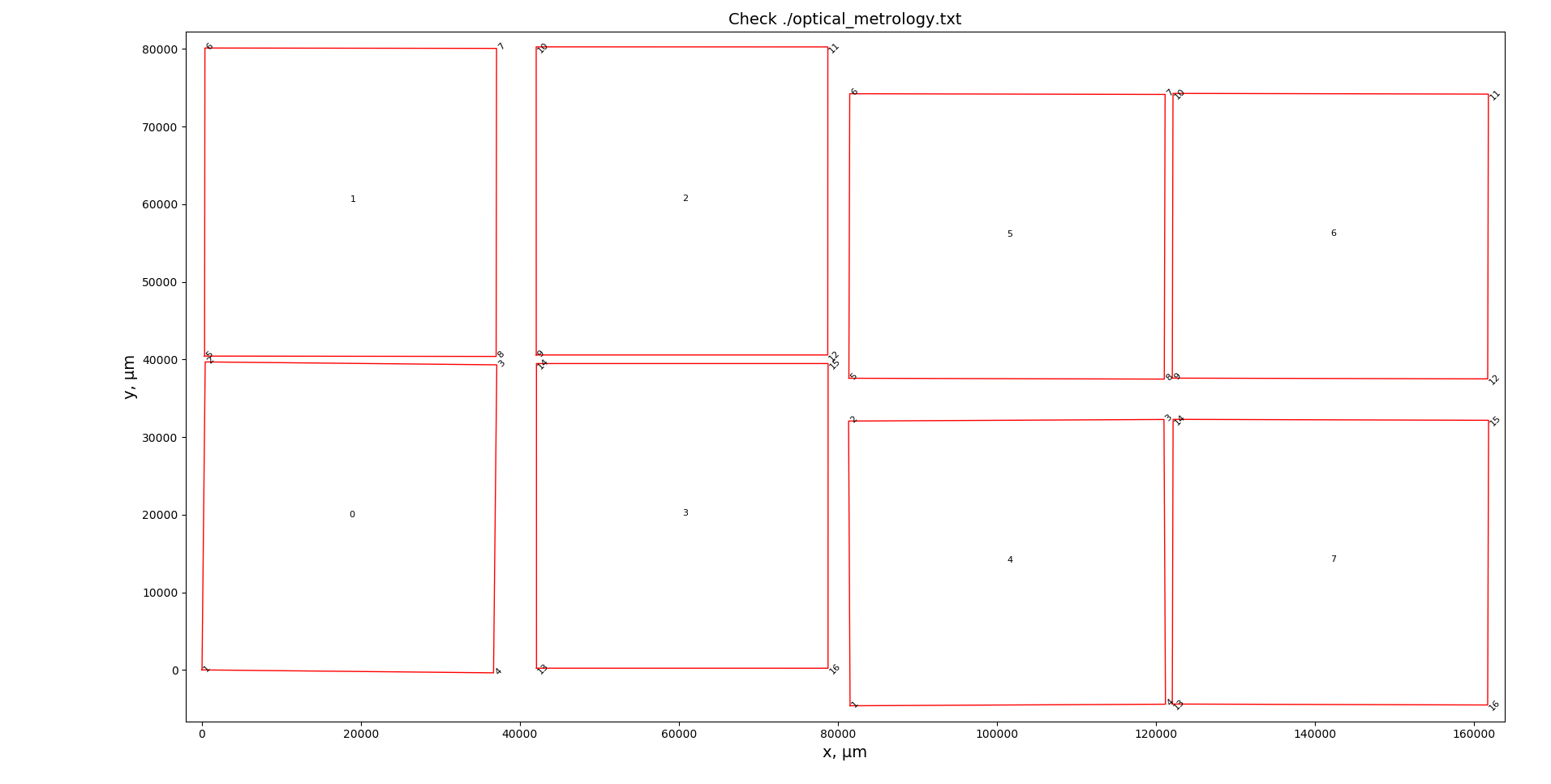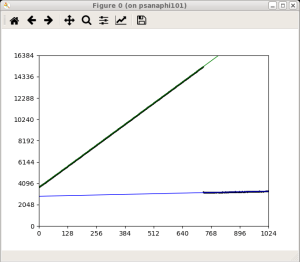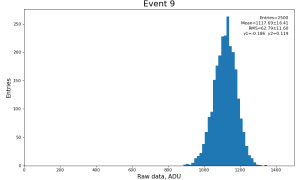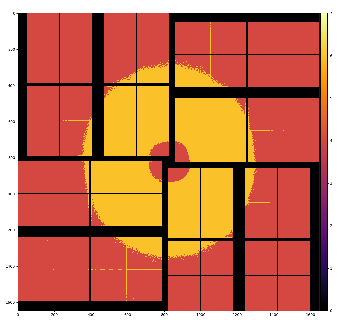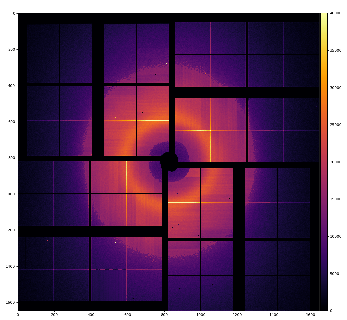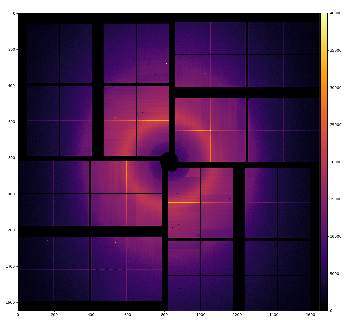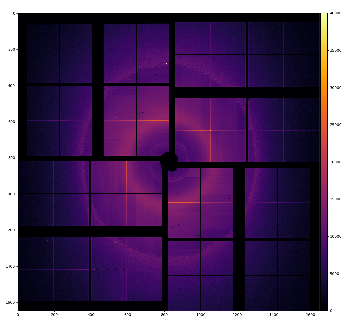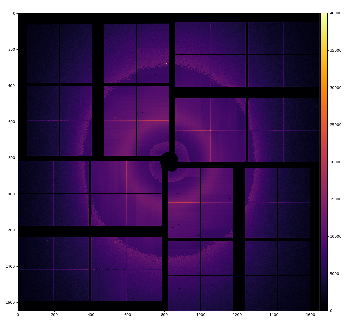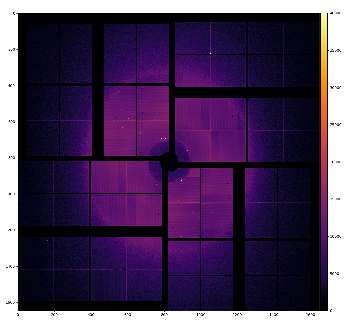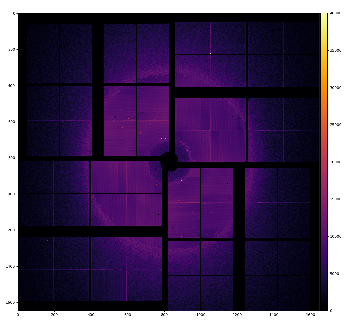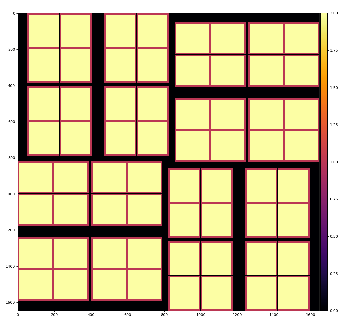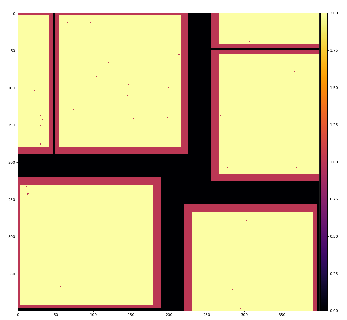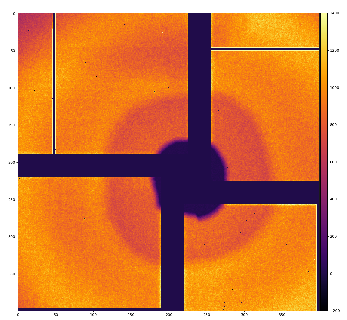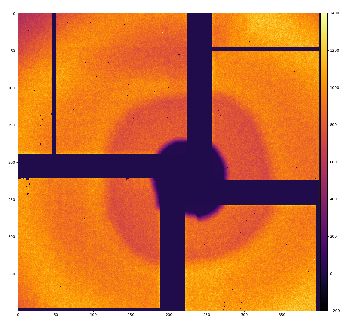Page History
...
- 2018-11-18-epix10ka2m-metrology-map.pdf
- 2018-11-18-epix10ka2m-metrology-map.pptx
- 2018-11-15-Metrology-epix10ka2m.xlsx
Front and back side of the new detector epix10ka2m.1 from mfxc00118 2020-07-dd
2020-10-04 MEC epix10kaquad 0 at optical metrology
2020-10-06 MEC epix10kaquad 0 front and back
2021-04-10 UED epix10kaquad
Comments on orientation of epix10ka2m parts from Matt
| Code Block | ||||
|---|---|---|---|---|
| ||||
Weaver, Matt Tue 10/92018-11-19, 37:0737 PMO'Grady, Paul Christopher;Dubrovin, Mikhail;Damiani, Daniel S. Hi Mikhail, We took radioactive source test Also, here'sruns sometoday descriptionto ofverify the nominal geometry. Pay closeWe attentionfound tothat thewe lastwere part that describes the positioning of ASICs within an "element". I think this might be different than before. -Matt // // Hard code the array's geometry for now // // (Epix10ka2m) // | // Quad 3 | Quad 0rotated by 90 degrees, which matches the labeling on the back of the detector as well as the metrology picture from Chris Kenney. The runs are /reg/d/psdm/det/detdaq17/e968-r0131 - source unmasked (up to ~ event 10000), then masked vertically after ~ event 15000 /reg/d/psdm/det/detdaq17/e968-r0132 - source masked horizontally at bottom after ~ event 15000. So, the picture is... // (Epix10ka2m) // | // Quad 0 | Quad 1 Quad 12 is rotated 90d clockwise // -------+-------- Quad 23 is rotated 180d clockwise // Quad 23 | Quad 12 Quad 30 is rotated 270d clockwise // | // // (Quad 01) // | // Elem 0 | Elem 1 // -------+-------- No rotations // Elem 2 | Elem 3 // | // // (Elem 0) // | // ASIC 0 | ASIC 3 // -------+-------- No rotations // ASIC 1 | ASIC 2 // | | ||||
| Code Block | ||||
| ||||
Weaver, Matt 2018-11-18, 6:14 PMDubrovin, Mikhail;O'Grady, Paul Christopher Here's the geometry I'm now using (below). Note that pixel(0,0) for each of the elements below is in the lower right hand corner. We'll know the quadrant layout for sure when we get the radioactive source exposure on Monday. // (Epix10ka2m) // // // (Elem 0-3 pixel array) // row increasing // |^ // Quad 3 | Quad 0 Quad 1 is rotated 90d clockwise // -------+-------- Quad 2 is rotated 180d clockwise| // Quad 2 | Quad 1 Quad 3 is rotated 270d clockwise // | // //column increasing (Quad<-- (0) // | // Elem 0 | Elem 1 // -------+-------- No rotations // Elem 2 | Elem 3 // | // The ASICs did not move. The change is that the (352,384) array has pixel (0,0) in the lower right hand corner (in ASIC2). // (Elem 0) // | // ASIC 0 | ASIC 3 // -------+-------- No rotations // ASIC 1 | ASIC 2 // | // // (Elem 0-3 pixel array) // row increasing // ^ // ,0) |
Preliminary geometry
in /reg/g/psdm/detector/data_test/calib/
| Code Block |
|---|
/reg/g/psdm/detector/data_test/calib/Epix10ka2M::CalibV1/NoDetector.0:Epix10ka2M.0/geometry/0-end.data @ (epix10ka2m - entire detector)
/reg/g/psdm/detector/data_test/calib/Epix10kaQuad::CalibV1/NoDetector.0:Epix10kaQuad.0/geometry/0-end.data @ (epix10kaquad - one quad)
/reg/g/psdm/detector/data_test/calib/Epix10ka::CalibV1/MecTargetChamber.0:Epix10ka.1/geometry/0-end.data @ (epix10ka - one panel) |
copy of geometry files in alignment examples /reg/g/psdm/detector/alignment/
| Code Block |
|---|
/reg/g/psdm/detector/alignment/epix10ka2m/calib/Epix10ka2M::CalibV1/NoDetector.0:Epix10ka2M.0/geometry/0-end.data
/reg/g/psdm/detector/alignment/epix10kaquad/calib/Epix10kaQuad::CalibV1/NoDetector.0:Epix10kaQuad.0/geometry/0-end.data
/reg/g/psdm/detector/alignment/epix10ka/calib/Epix10ka::CalibV1/MecTargetChamber.0:Epix10ka.1/geometry/0-end.data |
Optical metrology processing
Scripts for processing
| Code Block |
|---|
CalibManager/app/
optical_metrology_check
optical_metrology_epix10ka2m |
Results in
| Code Block |
|---|
/reg/g/psdm/detector/alignment/epix10ka2m/calib-mfx-epix10ka2m-01-2018-11-15/
2018-11-15-Metrology-epix10ka2m.xlsx
2018-11-15-Metrology-epix10ka2m.txt
2018-11-15-Metrology-epix10ka2m-corr.txt
2018-11-15-geometry-epix10ka2m.txt - geometry file accounting for optical metrology data
README-2018-11-15 |
Gain
| Code Block | ||||
|---|---|---|---|---|
| ||||
Blaj, Gabriel 2018-12-04, 2:08 PMO'Grady, Paul Christopher;Nelson, Silke;Dubrovin, Mikhail;Hart, Philip Adam | // | // column increasing <-- (0,0) |
| Code Block | ||
|---|---|---|
| ||
Weaver, Matt
2018-11-19, 7:37 PMO'Grady, Paul Christopher;Dubrovin, Mikhail
Hi Mikhail,
We took radioactive source test
runs today to verify the geometry. We found that we were rotated by 90
degrees, which matches the labeling on the back of the detector as well
as the metrology picture from Chris Kenney.
The runs are
/reg/d/psdm/det/detdaq17/e968-r0131 - source unmasked (up to ~ event 10000), then masked vertically after ~ event 15000
/reg/d/psdm/det/detdaq17/e968-r0132 - source masked horizontally at bottom after ~ event 15000.
So, the picture is...
// (Epix10ka2m)
// |
// Quad 0 | Quad 1 Quad 2 is rotated 90d clockwise
// -------+-------- Quad 3 is rotated 180d clockwise
// Quad 3 | Quad 2 Quad 0 is rotated 270d clockwise
// |
//
// (Quad 1)
// |
// Elem 0 | Elem 1
// -------+-------- No rotations
// Elem 2 | Elem 3
// |
//
// (Elem 0)
// |
// ASIC 0 | ASIC 3
// -------+-------- No rotations
// ASIC 1 | ASIC 2
// |
//
// (Elem 0-3 pixel array)
// row increasing
// ^
// |
// |
// column increasing <-- (0,0) |
Preliminary geometry
in /reg/g/psdm/detector/data_test/calib/
| Code Block |
|---|
/reg/g/psdm/detector/data_test/calib/Epix10ka2M::CalibV1/NoDetector.0:Epix10ka2M.0/geometry/0-end.data @ (epix10ka2m - entire detector)
/reg/g/psdm/detector/data_test/calib/Epix10kaQuad::CalibV1/NoDetector.0:Epix10kaQuad.0/geometry/0-end.data @ (epix10kaquad - one quad)
/reg/g/psdm/detector/data_test/calib/Epix10ka::CalibV1/MecTargetChamber.0:Epix10ka.1/geometry/0-end.data @ (epix10ka - one panel) |
copy of geometry files in alignment examples /reg/g/psdm/detector/alignment/
| Code Block |
|---|
/reg/g/psdm/detector/alignment/epix10ka2m/calib/Epix10ka2M::CalibV1/NoDetector.0:Epix10ka2M.0/geometry/0-end.data
/reg/g/psdm/detector/alignment/epix10kaquad/calib/Epix10kaQuad::CalibV1/NoDetector.0:Epix10kaQuad.0/geometry/0-end.data
/reg/g/psdm/detector/alignment/epix10ka/calib/Epix10ka::CalibV1/MecTargetChamber.0:Epix10ka.1/geometry/0-end.data |
Gain
| Code Block | ||||
|---|---|---|---|---|
| ||||
Blaj, Gabriel
2018-12-04, 2:08 PMO'Grady, Paul Christopher;Nelson, Silke;Dubrovin, Mikhail;Hart, Philip Adam
Hi,
You could try to use the gain files obtained with the pulser. They are not great but might work.
For a better gain calibration, we should use single photon data.
There is sufficient 1 photon data taken during the first testing at XCS,
but it will take me a few days to calculate the gains.
I would actually advocate returning the number of photons (as we
discussed in a meeting a few months ago). Even without a calibration it
can be easily calculated from the (average) gains:
High (FH and AHL): 132 ADU/9.5 keV
Medium (FM and AML): 43 ADU/9.5 keV
Low (FL, AHL, AML): 1.32 ADU/9.5 keV
(Just a note, while the pulser is not great for calibrating gains, it works fine for offset calibration)
Thanks,
Gabriel |
Gain factors from charge injection default and measured
| gain | charge injection | current default | measured (ADU / keV) |
|---|---|---|---|
| L | 0.46 | 0.01 | 0.139 |
| M | 15. | 0.3(3) | 4.5 |
| H | 46.7 | 1 | 13.9 |
Gain factors default vs charge injection
- Detector/examples/ex_epix10ka_images.py
- XcsEndstation.0:Epix10ka2M.0
- charge injection gain factors were generated from exp=xcsx35617:run=544
- data with water ring for comparison exp=xcsx35617:run=528
- account relative factor 46.7
- selected rect [6, 120:170, 200:250]
gain default: H / M / L = 1 / 0.33333 / 0.01
gain from charge injection:
| constants | Mean | RMS | RMS / MEAN |
|---|---|---|---|
| default | 1117.7 | 62.72 | 0.05618 |
| charge injection | 1177.5 | 66.79 | 0.05672 |
Conclusion: in this test charge injection gainci constants do not improve gain factors comparing to default
Test of the gain switching modes
offset calibration: exp=xcsx35617:run=544; its timestamp 20181129124822 faked with by reference from 20180101000000
dark runs: 413, 416, 417, 420 of xcsx35617
gain factors M, H=1, L= 0.2, 0.25, 0.3, 0.33333, 0.4
gain map images show that lateral and central-most pixels in mode H, M, "water ring" region pixels switched to L
data:
- AML: exp=xcsx35617:run=419, ev3
- AHL: exp=xcsx35617:run=414, ev3
Masks
mask_geo
mask_geo = det.mask_geo(par, mbits=3, width=10, wcentral=5)
- mbits = 1 - masks edges, +2 - masks central rows and columns.
- width - number of edge rows or columns to mask, def=1
- wcentral - number of central rows or columns to mask, def=1
plot for mask_geo + 1:
status_as_mask
- use pixel_status for exp=xcsx35617:run=544
- mask_status = det.status_as_mask(par, mode=0, indexes=(0,1,2,3,4))
- mode 0/1/2 masks zero/four/eight neighbors around each bad pixel
- indexes=(0,1,2,3,4) # indexes stand for FH, FM, FL, AHL-H, AML-M, respectively. Derived modes have the same status arrays.
found number of bad pixels
- 2802 for F gain modes and
- 3253 for all F + A mode
plots for mask_status + 1 for mode=0, 1 and 2:
Combined mask
mask = det.mask(par, calib=False, status=True, edges=True, central=True, width=10, wcentral=5, mode=0)
Calibrated data and mask
Image and spectrum for
- nda = calib_epix10ka_any(det, evt)
- nda *= det.mask(par, calib=False, status=True, edges=True, central=True, width=1, wcentral=1, mode=0)
References
Hi,
You could try to use the gain files obtained with the pulser. They are not great but might work.
For a better gain calibration, we should use single photon data.
There is sufficient 1 photon data taken during the first testing at XCS,
but it will take me a few days to calculate the gains.
I would actually advocate returning the number of photons (as we
discussed in a meeting a few months ago). Even without a calibration it
can be easily calculated from the (average) gains:
High (FH and AHL): 132 ADU/9.5 keV
Medium (FM and AML): 43 ADU/9.5 keV
Low (FL, AHL, AML): 1.32 ADU/9.5 keV
(Just a note, while the pulser is not great for calibrating gains, it works fine for offset calibration)
Thanks,
Gabriel |
Gain factors from charge injection default and measured
| gain | charge injection | current default | measured (ADU / keV) | 2020-08-03 Gabriel (ADU / keV) - use as default |
|---|---|---|---|---|
| L | 0.46 | 0.01 | 0.139 | 0.164 |
| M | 15. | 0.3(3) | 4.5 | 5.466 |
| H | 46.7 | 1 | 13.9 | 16.40 |
Gain factors default vs charge injection
- Detector/examples/ex_epix10ka_images.py
- XcsEndstation.0:Epix10ka2M.0
- charge injection gain factors were generated from exp=xcsx35617:run=544
- data with water ring for comparison exp=xcsx35617:run=528
- account relative factor 46.7
- selected rect [6, 120:170, 200:250]
gain default: H / M / L = 1 / 0.33333 / 0.01
gain from charge injection:
| constants | Mean | RMS | RMS / MEAN |
|---|---|---|---|
| default | 1117.7 | 62.72 | 0.05618 |
| charge injection | 1177.5 | 66.79 | 0.05672 |
Conclusion: in this test charge injection gainci constants do not improve gain factors comparing to default
Default gain correction factors
| Code Block | ||||
|---|---|---|---|---|
| ||||
Blaj, Gabriel <blaj@slac.stanford.edu> Mon 8/3/2020 6:52 PM
To: Hart, Philip Adam;
Dragone, Angelo;
Kenney, Christopher J.;
Dubrovin, Mikhail;
O'Grady, Paul Christopher;
Hansson, Conny;
McKelvey, Mark E
Hi, Here are some good starting values for the ADC to keV conversion:
High gain: 132 ADU / 8.05 keV = 16.40 ADU/keV
Medium gain: 132 ADU / 8.05 keV / 3 = 5.466 ADU/keV
Low gain: 132 ADU / 8.05 keV / 100 = 0.164 ADU/keV
Of course, a gain calibration is preferable.
The same numbers work in both fixed and auto-ranging gain modes.
Thanks,
Gabriel
=========
Blaj, Gabriel <blaj@slac.stanford.edu> Mon 8/3/2020 7:13 PM
Hi, For the long integration time, I don't have a set of magic numbers, but this iterative procedure should yield optimal settings:
Cool the camera as low as possible, just a few degrees over the minimum temperature to allow temperature stabilization by the PID control loop (either the chiller PID for the large cameras, or the Peltier PID in the small cameras). Of course, the small cameras can be cooled much lower than the large ones.
Start with the default LCLS settings (I believe both AsicAcqWidth and R0toAcq are set to 100us by default)
0 AsicAcqWidth should be optimized for the experiment. With a very cold camera (e.g., < -15ºC) you could go to 5ms. A good starting value would be 1ms.
1 Set AsicAcqWidth to, e.g., 1 ms
2 Set R0toACQ time to 100us
3 Decrease frame rate until no frames are dropped
4 Set the X-ray source to a low flux (0.01-0.05 photons/pixel/frame?)
5 Try to get a uniform illumination
6 Repeat:
- Calibrate dark
- Take many frames and integrate them
- Look if the resulting image is uniform or has a strange sawtooth pattern over each ASIC
- If no, try reducing R0toACQ
- If yes, try increasing R0toAACQ
- Increase/decrease frame rate to the maximum frame rate that runs reliably (no dropped frames).
6 Until an optimum is found.
For an idea how the strange sawtooth pattern looks, you could try setting:
AsicAcqWidth = 1ms
R0toAcq = 50us, or 20us.
Thanks,
Gabriel |
Test of the gain switching modes
offset calibration: exp=xcsx35617:run=544; its timestamp 20181129124822 faked for earlier dark calibrations by reference from 20180101000000
dark runs: 413, 416, 417, 420 of xcsx35617
gain factors M, H=1, L= 0.2, 0.25, 0.3, 0.33333, 0.4
gain map images show that lateral and central-most pixels in mode H, M, "water ring" region pixels switched to L
data:
- AML: exp=xcsx35617:run=419, event 3
- AHL: exp=xcsx35617:run=414, event 3
Masks
mask_geo
mask_geo = det.mask_geo(par, mbits=3, width=10, wcentral=5)
- mbits = 1 - masks edges, +2 - masks central rows and columns.
- width - number of edge rows or columns to mask, def=1
- wcentral - number of central rows or columns to mask, def=1
plot for mask_geo + 1:
status_as_mask
- use pixel_status for exp=xcsx35617:run=544
- mask_status = det.status_as_mask(par, mode=0, indexes=(0,1,2,3,4))
- mode 0/1/2 masks zero/four/eight neighbors around each bad pixel
- indexes=(0,1,2,3,4) # indexes stand for FH, FM, FL, AHL-H, AML-M, respectively. Derived modes have the same status arrays.
found number of bad pixels
- 2802 for F gain modes and
- 3253 for all F + A mode
plots for mask_status + 1 for mode=0, 1 and 2:
Combined mask
mask = det.mask(par, calib=False, status=True, edges=True, central=True, width=10, wcentral=5, mode=0)
Calibrated data and mask
Image and spectrum for
- nda = calib_epix10ka_any(det, evt)
- nda *= det.mask(par, calib=False, status=True, edges=True, central=True, width=1, wcentral=1, mode=0)
Manual alignment on 2019-05-06
Data
Ring-data (npy) arrays were provided for xcsx35617 run 400 by Silke, available under
- /reg/g/psdm/detector/alignment/epix10ka2m/calib-mfx-epix10ka2m-01-2018-11-15/2019-05-06-geometry-alignment/
Alignment tool
Manual Detector alignment tool (geo) is used for alignment. There is no automated geometry optimization in this tool.
Initial geometry
Alignment is started with the best geometry file obtained after optical metrology measurements for two quads, like
/reg/g/psdm/detector/alignment/epix10ka2m/calib/Epix10ka2M::CalibV1/NoDetector.0:Epix10ka2M.0/geometry/geo-epix10ka2m-v180
or
/reg/d/psdm/xcs/xcsx35617/calib/Epix10ka2M::CalibV1/XcsEndstation.0:Epix10ka2M.0/geometry/398-398.data
Alignment procedure
Quads' x0,y0 - center positions ONLY have been tuned as explained here:
1) Q0 and Q1 were moved together relative to the image center, because their geometry is constrained from optical metrology.
2) then Q2 and Q3 were moved independently in order to get consistent "to my eye" image relative to a set of drown circles.
Geometry for panels inside Q2 and Q3 is set from design geometry, and I do not feel that could do better job moving panels in quad.
There are some regular alignment issues with this detector; if I tune nicely (with precision ~ pixel size) rings in the middle of radial range,
then internal and external rings may be misaligned. This may be due to small tilt of the detector or non-accounted z position of panels
w/o optical metrology.
Results
Resulting geometry for this data looks like on attached image.
All files are available under
- /reg/g/psdm/detector/alignment/epix10ka2m/calib-mfx-epix10ka2m-01-2018-11-15/2019-05-06-geometry-alignment/
Recommendation for further geometry improvement
The only reliable procedure to get correct detector geometry is an 3-d optical metrology of entire detector.
After that one would need to adjust precisely
1) detector center relative to image with rings
2) sample-to-detector distance
3) detector plane tilts.
References
- EPIX10KA2M References
- EPIX10KA
- EPIX10KA2M data images and geometry
- Production of calibration constants for multi-panel epix10ka detectors
- EPIX10KA2M Charge injection fit issue
- EPIX10KA2M issue with panel 6 in mfxc00318
- EPIX10KA2M issue with panel 12 in xcsc00118 2M.0
- Optical metrology of epix10ka2m.1 from 2020-02-25
- EPIX10KA panel flatness measurement
- Jungfrau and Epix10ka Calibration
- Detector alignment tool
- 2020-08-20-new-x-ray-detector-snaps-1000-atomic-level-pictures-second-natures-ultrafast
...

